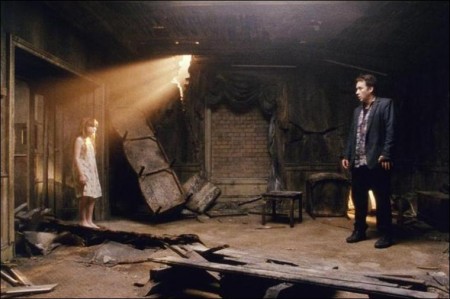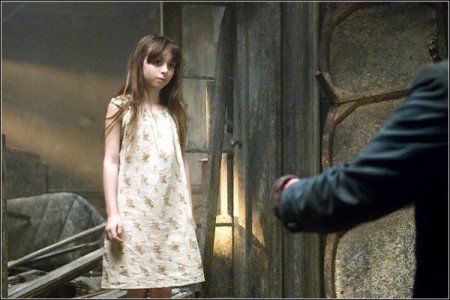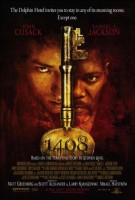Tagline: The only demons in room 1408 are those within you.
Adapted from the terrifying short story by suspense master, Stephen King. Renowned horror novelist Mike Enslin (John Cusack) believes only in what he can see with his own two eyes. But after a string of bestsellers discrediting paranormal events in the most infamous haunted houses and graveyards around the world, he has no real proof of life… afterlife.
But Enslin’s phantom-free run of long and lonely nights is about to change forever when he checks into suite 1408 of the notorious Dolphin Hotel for his latest project, “Ten Nights in Haunted Hotel Rooms.” Defying the warnings of the hotel manager (Samuel L. Jackson), the author is the first person in years to stay in the reputedly haunted room. Another bestseller may be imminent, but like many Stephen King heroes, first he must go from skeptic to true believer – and confront his demons to survive the night.
Well regarded—and Oscar-nominated—for films in his native country, Swedish writer/director Mikael Håfström gained the attention of American audiences and critics alike with the lurid 2005 thriller “Derailed,” starring Clive Owen and Jennifer Aniston as adulterous business executives. His latest effort, an adaptation of Stephen King’s chilling short story “1408,” takes Håfström into a completely different world, one created by the undisputed master of horror.
Håfström felt confident taking the helm of only his second English language film, however, when principal photography began on “1408” in London. He was pleased to be surrounded by most of his “Derailed” crew: Oscar1408 nominated editor Peter Boyle, costume designer Natalie Ward, and production designer Andrew Laws. Director of photography Benoît Delhomme rounded out the creative team. Furthermore, “We had a great script,” Håfström says, referring to the adaptation by prolific horror scribe Matt Greenberg and Golden Globe-winning screenwriters Larry Karaszewski and Scott Alexander. “And we had great actors.”
The lead player was John Cusack, one of Hollywood’s most popular and versatile actors, who had come aboard the project to play tormented author Mike Enslin. The actor had seen “Evil,” Håfström’s 2004 drama that was nominated for an Oscar for Best Foreign Language film, and was “very impressed by it. I really liked that film, and I thought he was very talented,” explains Cusack. “Mikael’s got a real wisdom about how to approach these things.
“He’s Swedish, and Swedes are very nice, but they have this great sense of foreboding,” he adds. “They’re definitely in touch with their inner doom.”
Håfström was delighted to be directing Cusack, a star known not only for his acting ability, but his likeability. “Men like him and women like him,” says Håfström. “He brought that likeability to this cynical character.”
Cusack’s ability to endear himself to audiences was essential to the success of the narrative, says Håfström. “It was very important that we set Enslin up so that the audience wants to follow him through this journey,” he says. “The audience needs to not only understand him and where he is in life, but like him.”
To prepare for his role, Cusack read the Stephen King short story on which the film is based. It was originally part of an audio book and subsequently published in the 2002 short story collection “Everything’s Eventual.”
“It’s really terrific, and it’s a lot of fun,” he says. “King is a master storyteller, but he also has a kind of pulp sensibility. He knows how to make these stories really juicy and terrifying and vibrant.
“I don’t know how he knows how to scare people so intensely, or where those impulses come from, but King is definitely channeling some spirits and demons,” continues Cusack.
Cusack’s character writes novels about famous haunted houses and other spine-tingling places around the world, exploring all manner of myths and legends along the way. He’s also experienced a profound tragedy in his life.
Håfström describes Enslin as a wayward soul still suffering from the loss of his young daughter. “He is a guy who has lost his way,” says the director. “He’s sad and depressed, and he’s searching for something.”
After receiving a tantalizingly vague postcard alluding to the 1408 mystery, Enslin decides the story will provide the material for the last chapter in his new book, “Haunted Hotel Rooms.” Enslin checks in to New York’s Dolphin Hotel and meets Mr. Olin, the hotel’s general manager. “Enslin sees 1408 as part of an elaborate con Olin and his staff are pulling,” says Cusack.
Soon, however, “Things start to really happen and it becomes a Hotel California,” says Cusack. “The room takes on a personality and becomes a character. It actually attacks.”
“Mike Enslin meets horror in the form of his own demons in 1408,” says Håfström, “and he has to fight them.”
Samuel L. Jackson portrays Olin, a relatively minor character in the story whose role was expanded for the film.
“I’ve always loved Sam’s work,” says Cusack. “You can think of a lot of people who can play Olin, but then you think of Sam Jackson—if Sam Jackson tells you not to go in that room, you shouldn’t go in that room!”
“Olin has been the manager of the hotel for a while now, and he’s very proud of it,” says Jackson of his character. “He tries to keep people out of 1408.
For one reason, as he says, he doesn’t want to clean up the mess. He’s had four deaths happen while he’s been in charge of the hotel, and they haven’t been pleasant experiences.
“It doesn’t exactly enhance the reputation of the hotel,” he adds. Jackson describes the film as “a paranormal sort of thriller. There’s something very real that takes place in that room,” he says. “Who knows what it is or why?”
Rounding out the core cast is Mary McCormack, who plays Mike Enslin’s estranged wife, Lilly.
McCormack wasn’t familiar with the work of Håfström, but her sister-in-law is a good friend of the director. “She was yelling at me for not being familiar with every minute of his work!” she laughs. “Family and friends and people who have worked with him in L.A. just rave about him. So I knew I was in good hands.”
As for Stephen King, she says, “He does creepy better than anyone else. And does it in a really believable way, which makes it much more horrifying.”
The actress was most intrigued by the complex relationship between Mike and Lilly. “You see some glimpses of their relationship when it was healthy, but mainly it has never been the same since their daughter passed away,” she explains. “They’ve been estranged for years, but I think they’re still in love.
They’ve fallen into a trap—not talking about it, not mourning the same way, and then having nothing to discuss except the subject that neither of them wants to discuss.”
McCormack also admired the way the screenplay put a new spin on a well-trod genre. “Genre-wise this film is tricky, but I like that. It makes it interesting,” she says. “It’s not really a horror movie because it’s not a slasher film—but it’s horrifying. It’s sort of a ghost tale and a psychological thriller as well.
In the end I don’t know if you’re really sure what was real and what was just in Mike’s mind.”
This blurring of the line between fantasy and reality is a major theme of the film.
“The film has this dream logic to it,” says Cusack. “A lot of the things that Mike sees are things that could have been, might have been, or were his worst nightmare.”
The room is haunted with a spirit that manipulates whatever events its occupants bring in with them from their pasts. “Mike starts to see visions, but it’s all stuff that’s happened to him, and it’s maybe half true,” says Cusack of Enslin’s fantastic journey. “He sees members of his family, past relationships, and deceased people that he had unfinished business with.
“It’s as much of a metaphysical mind bender as it is a horror film. You don’t quite know if the hotel room is really doing this to Enslin or if it’s just his projections,” he continues. “This film is definitely designed to make you think, and make you scared, and make you feel like you might have a split personality.”
Most of the film is indeed Cusack acting alone, wrestling with nothing but his character’s demons in the confines of a hotel room.
“It was very challenging because there’s nothing to cut away to,” admits Cusack. “You don’t know if you can pull it off.”
“It was challenging to have one character to work with for such a long amount of time in one room,” agrees Håfström. “It’s not a conventional storyline. You have to make it up as you go along a little bit and keep it interesting.
“We couldn’t do much without John or his energy,” admits Håfström. “I think that intrigued him and challenged him as an actor.”
Cusack didn’t want the film to rely too heavily on computer-generated effects. Håfström agreed: “It was very important to me that ‘1408’ not look like a visual effects film,” says the director. “I didn’t want the audience to be able to say, ‘oh, that’s a visual effects shot.’”
“In the second or third act things get pretty wild, but mostly it was me in the room, and some people playing spirits or ghosts,” Cusack points out. “It’s not like we threw up a green screen and just pretended to do the whole thing.”
About 400 visual effects shots were used to create the more elaborate moments in the film. “The water bursting into the room, the room turning into a ship, the wall cracking—we tried to do as much as we could practically,” says Håfström. “When we cracked the wall, for example, we cracked it for real.”
The Swede had never done a film with so many complicated effects. “It was a learning curve for me,” he says. “We tried to not make it over-the-top. We tried to integrate the effects into the general feel of the movie.”
In addition to mastering the visual effects arena, another challenge for Håfström was deciding how to end the film.
“Stephen King’s short story doesn’t really have a cinematic ending. So we had a lot of debates, and we worked on different kinds of endings,” says Håfström, who promises that viewers will be treated to the alternate endings on the DVD version of the film. “After test screenings, we decided on the ending that we now have because we felt that it was most satisfying not only for the audience, but for the character and for us.
“We had to shoot the bulk of the film before we actually could see where the ending would take us,” he explains. “In this case it was very difficult to know the direction we would go beforehand.”
So would the actors themselves stay in 1408 if presented with the opportunity?
“I would stay in 1408 because it’s a hotel. I’d think, ‘well I could just get out,’” says John Cusack. “But I wouldn’t go 20 miles out in the country to a haunted place by myself. I’m way too terrified for that.”
“I’d probably stay well away from 1408,” offers Samuel L. Jackson, who remembers being highly superstitious as a kid. “You just can’t mess around with stuff that is forbidden.”
“Why would I stay in 1408? There are so many other rooms,” says Mary McCormack. “I mean, I’m not actually afraid of ghosts. But still, there are a lot of other rooms, right? Where’s the upside for me?”
As for Håfström, he just hopes that the audience’s imaginations are ignited. “I hope that viewers will make Mike Enslin’s journey their own journey. I want them to wonder, ‘What would happen to me in 1408?’
“I also want them to have a good ride,” says the director. “‘1408’ is great entertainment.”
Production notes provided by Dimension Films.
1408
Starring: John Cusack, Samuel L. Jackson, Mary McCormack, Tony Shalhoub
Directed by: Mikael Håfström
Screenplay by: Matt Greenberg, Scott Alexander, Larry Karaszewski
Release Date: June 22nd, 2007
MPAA Rating: PG-13 for thematic material disturbing sequences of violence and terror, frightening images and language.
Studio: Dimension Films
Box Office Totals
Domestic: $71,985,628 (55.0%)
Foreign: $58,824,585 (45.0%)
Total: $130,810,213 (Worldwide)



